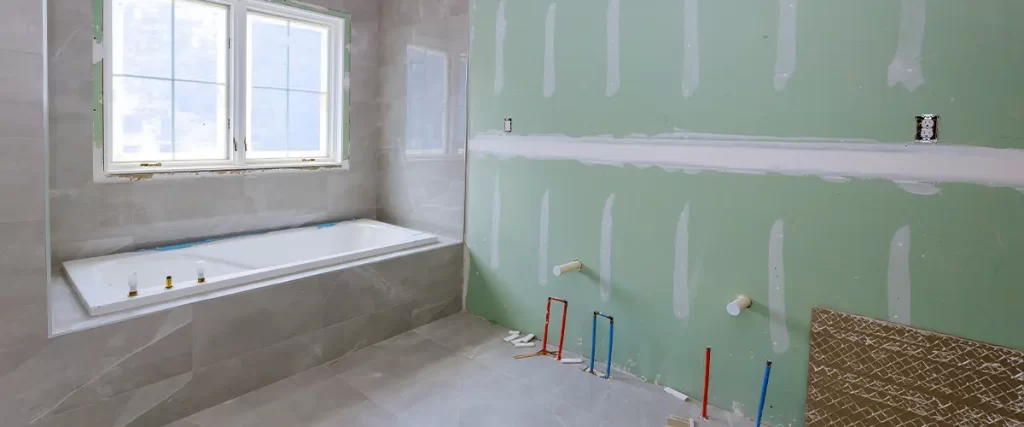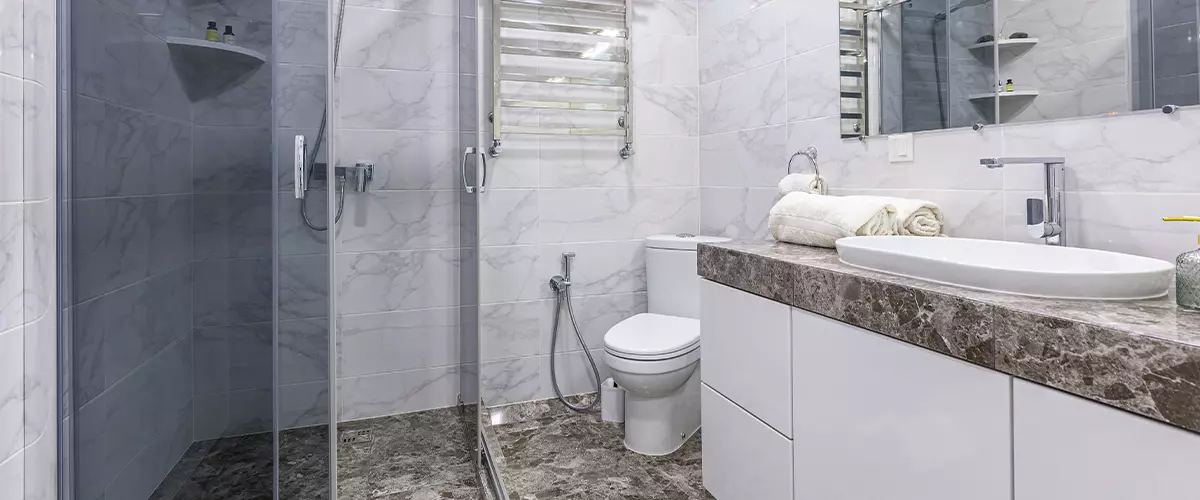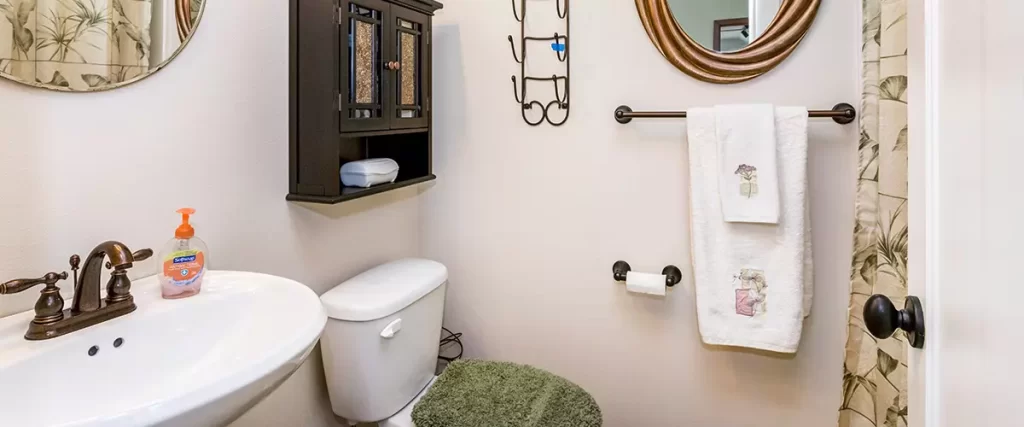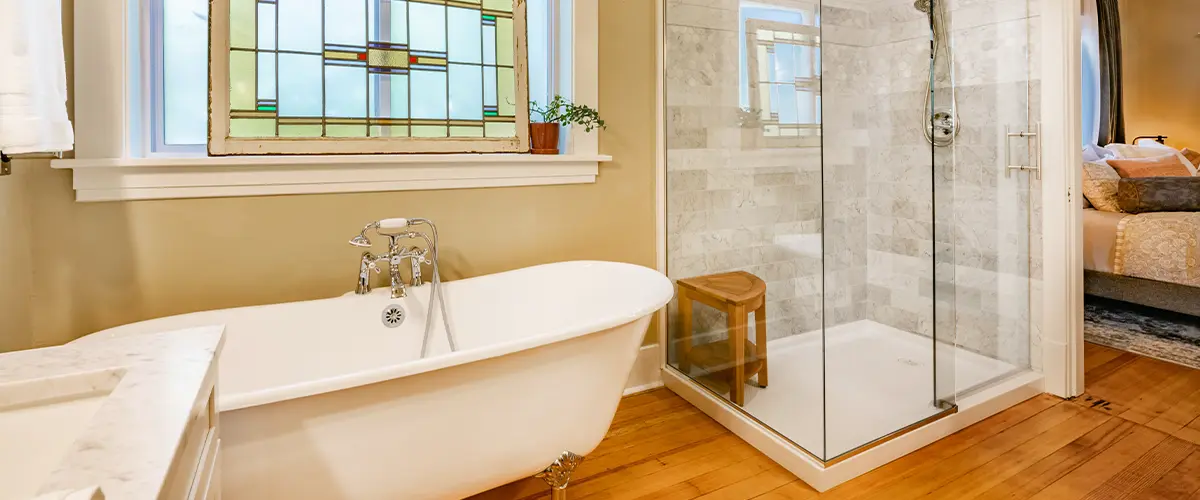Are you renovating your bathroom and puzzled about moving its plumbing?
Moving bathroom plumbing is a project 85% of homeowners find intimidating. This comprehensive guide will unpack everything you need to know, from understanding various aspects of your plumbing system to real-world tips for avoiding common pitfalls.
Ready to transform that daunting task into an achievable goal? Let’s dive in!

Key Takeaways
- Moving bathroom plumbing can be simple with the right knowledge. Learn about your water, drainage, and ventilation systems before starting.
- Always inspect your current setup first. This will guide you in planning what changes need to be made.
- Consider hiring a professional plumber. They have experience and save you time fixing errors or learning new tasks by yourself.
- Look for ways to prevent leaks or other problems during renovations. These could include regular checks of pipes, proper sealing of joints, pressure testing after work completion, etc.
- Changing the layout not only gives a fresh look but also ensures efficient usage of space and adds value to your home!
Understanding Bathroom Plumbing Systems
In order to effectively move bathroom plumbing, you need to have in-depth knowledge of the three main parts of a bathroom’s plumbing system: the water supply system, draining system, and ventilation system.
The water supply is responsible for delivering clean water to your fixtures (sink, shower, toilet), whereas the drainage takes away used water or wastewater. The ventilation allows air into the pipes, maintaining proper atmospheric pressure in them, which prevents backflow or sewer gases from reaching your home.
Water Supply System
The water supply system plays a crucial role in your bathroom’s functionality. Its primary job is to bring fresh water into your home, directing the flow to various fixtures such as sinks, toilets, and showers.
Pipes that make up this system typically come from underground, connecting directly to a local municipality water source or a well if you are living in rural areas. A sudden drop in pressure or unexplained dampness on floors or walls may indicate issues with the water supply system, which certainly require immediate attention.
Always prioritize regular checks and maintenance to ensure it’s operating at its optimal capacity; having safe and clean running water is essential for any household.
Drainage System
Drainage systems manage wastewater and ensure that it flows correctly out of your home. These are essential parts of bathroom plumbing, comprising drain pipes from toilets, sinks, showers, and bathtubs.
When moving a bathroom plumbing system, the positioning of these drains is critical to prevent unwanted blockages or backups.
In most homes built on concrete slabs or without basements, you’ll find drainage pipes running under the ground floor. However, in houses with basements or crawl spaces underneath them, these lines typically run just above lower-floor ceilings and beneath upper floors.
The process could involve rerouting existing pipelines around obstructions like supporting joists or electrical wiring while ensuring all fixtures have proper access to the drainage network.
Ventilation System
Your home’s ventilation system plays an essential role in bathroom plumbing. It equalizes the pressure within drain lines, ensuring wastewater and solid waste move out of your house efficiently.
Installing a well-functioning ventilation system can prevent messy issues like water backflows or sewer gases entering your house from the drains. Vent pipes typically run vertically upwards via walls, attics, or utility rooms and extend to release gas outdoors through roofs.
Experienced plumbers take into account the size of these vent pipes to match them properly with corresponding drain lines for optimal performance. Hence, while moving a bathroom location or undergoing any renovation project, you need to plan thoroughly for modifications in your ventilation system along with other fixtures such as sinks and toilets.

Important Considerations for Moving Bathroom Plumbing
Before starting a bathroom plumbing move, it’s crucial to scrutinize your existing plumbing layout, plan for the new setup and fixtures you’ll need, and enlist the assistance of a skilled plumber who can help execute the project efficiently.
Assessing the existing plumbing layout
Starting the journey of bathroom renovation involves an initial step of assessing the existing plumbing layout.
- Look for visible water lines and drains. Typically, they are under your sink or behind the toilet.
- Check out the access panel, usually located in a utility room or adjoining room to the bathroom. It provides access to pipes that disappear into walls or ceilings.
- Identify your water supply system’s points, including hot and cold – water feeds from a water source like a well or city supply.
- Take note of pipe materials, as this will affect your project; copper, PVC, and PEX tubing are common types used in houses today.
- Trace where these pipes connect to different fixtures like your shower, sink, or toilet.
- Figure out if waste drains run through floor joists or beneath subfloors or a concrete slab.
- Scan for any electrical wiring near plumbing work; they must be kept separate for safety reasons.
Determining the new layout and fixtures
Crafting your dream bathroom involves several crucial steps, one of which is determining the new layout and fixtures. Here’s a simple and straightforward process to help you make these critical decisions:
- Start by brainstorming your ideal bathroom layout. Consider factors such as space, comfort, functionality, and ease of movement.
- React to the current bathroom’s limitations in your plans. This may involve moving bathroom plumbing or rerouting some pipes for more efficient use of space.
- Decide what fixtures will adorn your newly renovated bathroom – everything from sinks and toilets to bathtubs or showers plays an important role.
- Keep an eye on your budget while selecting new fixtures. There are plenty of budget-friendly options that do not compromise on quality or aesthetics.
- Take note of how you will connect water lines to the newly placed fixtures.
- Hire a utility room planner if you feel lost during this phase; their expertise can save you from unexpected costs in both time and money.
- Stay flexible with those plans as renovations often involve surprises once floor joists and walls are opened up; be ready to adapt them accordingly.
Hiring a professional plumber
Professional plumbers bring a wealth of expertise to your bathroom renovation project. They can accurately assess the current plumbing layout, anticipate issues with water supply pipes and drain lines, and recommend best practices for moving bathroom plumbing.
Not only do they have the skills and knowledge needed for this complex work, but hiring a plumber also saves you the time and effort that might go into learning DIY techniques or correcting possible mistakes made along the way.
Unexpected difficulties often arise during renovations; these could range from working around supporting joists in the wall or floor to dealing with unexpected costs related to changing the complete bathroom layout.
By involving a professional at an early stage, homeowners ensure swift resolution of such problems while sticking to budget schedules as much as possible.

Common Challenges and Solutions
Navigating the hurdles of bathroom plumbing relocation, such as existing pipe connections and potential leaks, can be tricky but certainly manageable.
Highlighting important solutions like ensuring sufficient water flow and addressing typical plumbing issues will set you up for a successful remodel.
Stay with us to learn more about these challenges and their effective fixes.
Dealing with existing pipes and connections
Reconfiguring your bathroom layout involves dealing with existing plumbing. It can be overwhelming, but knowing how to approach it simplifies the process:
- Identify and label all pipes: Carefully trace all water supply and waste drain lines in your bathroom to understand the complexity of the project.
- Examine pipes for any signs of damage or leaks: Prior to moving anything, check your existing plumbing for weaknesses that could cause trouble down the line
- Disconnect safely: Turn off water feeds before disconnecting any pipes. This prevents potential flooding and damage.
- Discover any hidden pipes: Explore behind walls, under floor joists, or above ceilings. Remember, there might be pipes running out of sight!
- Consider pipe materials: Traditional copper or new PEX tubing? Each has its perks and downsides.
- Plan for water source shift: Moving toilets or other fixtures usually means rerouting their water lines to a new location.
- Seek professional advice: Engage a professional plumber if you’re unsure about making changes yourself; their expertise might save more money than expected costs of surprise damages.
- Respect building codes: Be aware that drastic plumbing work may require permission from local authorities.
Addressing potential leaks and plumbing issues
Potential leaks and plumbing issues are inevitable during bathroom renovation projects, but they can be effectively addressed. Here’s how:
- Regular inspections of all pipes: Early detection helps in addressing leaks before they escalate.
- Replacing old pipes: Older or damaged pipes are more prone to leakages, replacing them with new ones can prevent this problem.
Sealing joints properly: Ensure all pipe joints are sealed correctly to stop any potential leaks. - Checking for signs of water damage: Look out for water stains, discoloration, or soft spots on the walls or ceiling – these could indicate a hidden leak.
- Application of thread tape: This will help solve any drip issues around threaded connections, especially at showerheads and faucets.
- Installing an access panel: It simplifies future plumbing repairs and makes the detection of issues more straightforward.
- Monitored pressure testing: After moving your bathroom plumbing, mandated pressure tests should be carried out to uncover any concealed leakage problems.
- Hiring competent plumbing professionals: These experts possess the necessary experience and skills to identify imminent leakage problems and fix them promptly.
Ensuring proper water pressure and flow
Maintaining the right water pressure is pivotal in your bathroom plumbing project. Go for a steady and strong flow across all fixtures while avoiding pressure that’s too high, which can damage pipes over time.
To regulate this, plumbers install devices known as water pressure-reducing valves. Then comes ensuring suitable directional flow from water supply lines to each fixture like toilets, sinks and showers in your new layout: keeping track of hot and cold feeds is crucial here.
Consider bringing in an expert plumber to inspect and fine-tune this delicate balancing act between good flow rate and ideal pressure since doing it yourself might risk imbalances or system malfunctions further down the line.
Tips for a Successful Bathroom Plumbing Move
Craft a detailed plan noting every step of your bathroom remodel and calculate all expected costs to ensure you stay within budget. Thoroughly label each plumbing fixture before disconnecting them to avoid confusion during reconnection.
Make sure to run a comprehensive test on the new plumbing system before final installation; identifying any issues or leaks early can save time and money later. Finally, consider integrating unique amenities into your new layout for optimal comfort and accessibility; this could include installing grab bars in showers for safety or adding luxury features like heated floors.
Create a detailed plan and budget
Creating a detailed plan and budget is the first crucial step in moving bathroom plumbing. Start by identifying all tasks related to the project, which may include rerouting water lines and waste drains, installing new fixtures, or hiring professional services.
Note each step on paper to ensure nothing falls through the cracks. Next, determine expenses associated with each task, such as labor costs for plumbers or materials for installations. This will help you foresee unexpected costs that could spiral your budget out of control.
Be sure to review rates from different suppliers or contractors before deciding where to spend your money – an essential part of maximizing your output without compromising quality!
Properly label and disconnect plumbing fixtures
Properly labeling and disconnecting plumbing fixtures is a vital step in your bathroom renovation project. Here’s a step-by-step guide:
- Start with a clear and comprehensive labeling system for your existing pipes and fixtures.
- Use color codes or tags to identify hot and cold water lines, drain lines, and vent pipes.
- Document the initial layout of all fixtures before you start disconnecting them.
- Cut off the water supply to prevent leaks during the disconnection process.
- Carefully remove fixtures such as faucets, showerheads, toilets, sinks, bathtubs without damaging them
- Disconnect the water supply lines to each fixture using proper tools
- Ensure to also disconnect and label any related electrical wiring for things like electric showers or whirlpool tubs.
- Lastly, cap off all open pipes to prevent sewer gas from entering your home during the renovation process.
Test the new plumbing system before finalizing the move
Ensuring the functionality of your new bathroom plumbing system is essential during the project.
- Start by checking all connections in your new bathroom layout. Inspect all pipes and fixtures for secure installation and connection.
- Proceed to turn on the water supply. Monitor each fixture closely for leaks and correct water pressure.
- Conduct a drain test on every bathroom fixture. Fill sinks, tubs, and showers with water, then drain them simultaneously to verify proper drainage function.
- Try flushing the toilet multiple times while other fixtures are draining. This ensures that your waste drain can handle simultaneous usage.
- If you notice any issues, such as leaking or slow draining, address these immediately. Consulting a professional plumber may be necessary if you encounter complex problems.
- Ensure consistent hot water flow in all showers and sink faucets by testing them together. If hot water fluctuates or runs out quickly, consider upgrading your water heater capacity.
Consider adding additional features for convenience and accessibility
Installing new fixtures that boost convenience and accessibility also falls into the plan when moving your bathroom plumbing. This could involve adding dual shower heads for a luxurious bathing experience or installing grab bars to make your bathroom safer, especially for older family members.
Integrating modern features like touchless faucets can help in conserving water while improving hygiene. Think about the potential needs of everyone who might use the space and choose upgrades that will genuinely improve utility and comfort in your transformed bathroom.
Making these smart additions not only adds to functionality but also amps up the overall value of your home improvement project.

Moving Bathroom Plumbing FAQs
Conclusion
In your journey of upscale bathroom remodeling, you don’t have to navigate the complex process of moving plumbing on your own. At Remodeling Journey, we’re committed to taking the legwork out of your project.
We have the expertise to handle all aspects of bathroom renovation, ensuring you get the ideal blend of luxury and functionality. Don’t hesitate to contact us at (715) 551-7328 – we’re here to turn your dream bathroom into a reality.
